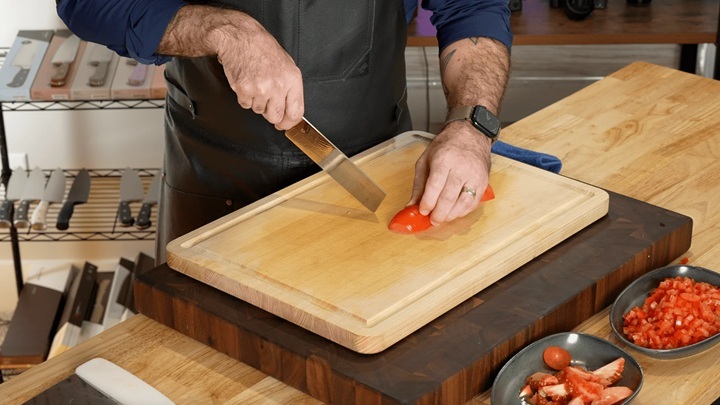6 Reasons to Consider Adding a Nakiri Knife to Your Kitchen
Have you ever noticed how much easier cooking is when you’ve got a really good knife? However, many people don’t understand the fuss until they get a proper Japanese knife. Total game-changer. It just glides through veggies like butter. Makes prepping meals more fun and convenient, as they’re so sharp and feel right in your hand.
If you love cooking fresh meals at home and you’re all about clean cuts and making food prep a bit more fun, check out the Nakiri knife – once you try it, you’ll see what everyone’s talking about.
What Is the Nakiri Knife Used For?

This Japanese knife is designed specifically for chopping, slicing, and dicing vegetables with its straight, thin blade. Perfect for cutting vegetables and greens. Its straight edge allows for precise cuts without damaging or bruising delicate vegetables.
But another common question people ask is: Can I use a Nakiri to cut meat? Yes, but mainly boneless meat because it’s not quite suitable for cutting bones or very hard vegetables. However, you can also use it for chopping soft ingredients like tofu and fruit. These masterpieces of knives are a favourite in both professional kitchens and home cooking for vegetable preparation.
With that being said, let’s dive deeper into why you should get a Nakiri knife and why it’s a really smart move.
Vegetable-Friendly Design
So, why is Knakiri such a big deal for veggies? Well, first of all, it’s designed specifically for vegetables. The flat, rectangular blade allows for clean, straight cuts, making it perfect for slicing, dicing, and chopping all kinds of produce. Unlike curved blades, it doesn’t require a rocking motion, which means more efficient and precise cuts.
It also helps with delicate veggies, too. The sharp edge minimises bruising and preserves the freshness of delicate items like tomatoes and herbs. It’s also great for making thin, even slices, which is ideal for salads or garnishes. It simply makes prep work way easier. Plus, the wide blade makes it easy to scoop up chopped veggies and transfer them to the pan, saving time and reducing mess.
Precision and Efficiency
What about precision and efficiency? How does it compare to other knives? Well, the Nakiri excels in precision. Its straight edge and sharp blade allow for uniform cuts, which is essential for even cooking. It’s especially useful when you need to make consistent slices for dishes like ratatouille or stir-fries.
And also, since it’s designed for an up-and-down motion, you can chop quickly without the need for a rocking motion. This not only speeds up prep time but also reduces strain on your wrist. It’s a tool that enhances both the quality of your cuts and the overall cooking experience.
Ergonomic and Comfortbale Desing
The Knakiri knife is a Japanese design that is comfortable to use for extended periods. It boasts an ergonomic design – the handle is crafted to provide a comfortable grip, and the knife is well-balanced, reducing hand fatigue during long prep sessions. And that’s important, especially when cooking for a crowd.
The lightweight design and comfortable handle make it easier to maintain control and precision, even when chopping large quantities of vegetables.
Versatility in the Kitchen
So, is the Nakiri versatile, or is it just for veggies? While it’s optimised for vegetables, it’s quite versatile. You can use it for fruits, herbs, and even boneless meats. Though not ideal for cutting through bones, it’s a reliable tool and an all-around good knife for most kitchen tasks, especially if you prepare a lot of plant-based dishes. Its design makes it efficient for a variety of tasks beyond just chopping vegetables.
Aesthetic Appeal and Craftsmanship
These Japanese knives look pretty sleek, too. Many of them feature beautiful craftsmanship, with high-quality materials and attention to detail. Some even have Damascus steel patterns, making them as attractive as they are functional. So they add a touch of elegance to the kitchen as well.
You can say that they’re not just tools, but pieces of art that reflect the rich tradition of Japanese knife-making.
Easy Maintenance and Longevity
With just a little bit of proper care, these Japanese knives are very easy to maintain. Hand washing and drying immediately after use will keep the blade in good condition. Regular honing will maintain its sharpness, and occasional sharpening will keep it performing at its best.
Also, with proper maintenance, a quality knife can last for many years. The high-quality steel used in these knives is designed for durability and long-term use. It’s an investment that pays off in the long run.
